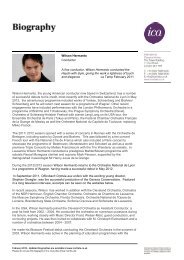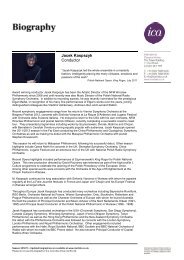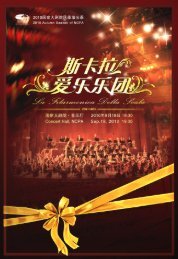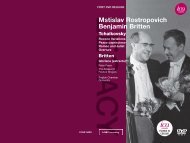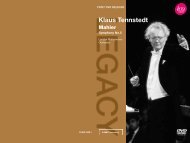Boston Symphony Orchestra Charles Munch - International ...
Boston Symphony Orchestra Charles Munch - International ...
Boston Symphony Orchestra Charles Munch - International ...
Create successful ePaper yourself
Turn your PDF publications into a flip-book with our unique Google optimized e-Paper software.
FIRST DVD RELEASE<br />
Beethoven<br />
Symphonies<br />
Nos.4 & 5<br />
Die Geschöpfe<br />
des Prometheus<br />
(extracts)<br />
<strong>Boston</strong> <strong>Symphony</strong> <strong>Orchestra</strong><br />
<strong>Charles</strong> <strong>Munch</strong><br />
ICAD 5016<br />
s
LUDWIG VAN BEETHOVEN 1770–1827<br />
Die Geschöpfe des Prometheus, op.43 (extracts)<br />
The Creatures of Prometheus · Les Créatures de Prométhée<br />
1 Ouverture: Adagio — Allegro molto con brio 5.30<br />
2 No.5: Adagio — Andante quasi allegretto 8.43<br />
3 No.16: Finale: Allegretto — Allegro molto 5.47<br />
Directed by David M. Davis<br />
Produced by Jordan M. Whitelaw<br />
Recorded: Sanders Theatre, Harvard University, 8 March 1960<br />
π & © 1960, 2011 <strong>Boston</strong> <strong>Symphony</strong> <strong>Orchestra</strong> & WGBH Educational Foundation<br />
Taken from a broadcast produced by the <strong>Boston</strong> <strong>Symphony</strong> <strong>Orchestra</strong> in association<br />
with Seven Arts Associated Corp.<br />
Digitisation by Safe Sound Archive<br />
<strong>Symphony</strong> No.4 in B flat major, op.60<br />
4 I Adagio — Allegro vivace 10.53<br />
5 II Adagio 9.14<br />
6 III Allegro vivace 4.48<br />
7 IV Allegro ma non troppo 5.39<br />
Directed by David M. Davis<br />
Produced by Jordan M. Whitelaw<br />
Recorded: Sanders Theatre, Harvard University, 18 April 1961<br />
π & © 1961, 2011 <strong>Boston</strong> <strong>Symphony</strong> <strong>Orchestra</strong> & WGBH Educational Foundation<br />
Taken from a broadcast produced by the <strong>Boston</strong> <strong>Symphony</strong> <strong>Orchestra</strong> in association<br />
with Seven Arts Associated Corp.<br />
<strong>Symphony</strong> No.5 in C minor, op.67<br />
8 I Allegro con brio 6.42<br />
9 II Andante con moto 11.37<br />
10 III Allegro — 5.11<br />
11 IV Allegro 8.41<br />
Directed by David M. Davis<br />
Produced by Jordan M. Whitelaw<br />
Recorded: Sanders Theatre, Harvard University, 3 November 1959<br />
π & © 1959, 2011 <strong>Boston</strong> <strong>Symphony</strong> <strong>Orchestra</strong> & WGBH Educational Foundation<br />
Original broadcast produced by the <strong>Boston</strong> <strong>Symphony</strong> <strong>Orchestra</strong> in association with the<br />
Lowell Institute Cooperative Broadcasting Council, WGBH TV, <strong>Boston</strong>, and NERTC (National<br />
Educational Radio and Television Center)<br />
Digitisation by Safe Sound Archive<br />
<strong>Boston</strong> <strong>Symphony</strong> <strong>Orchestra</strong><br />
CHARLES MUNCH<br />
For ICA Classics<br />
Executive Producer: Stephen Wright<br />
Head of DVD: Louise Waller-Smith<br />
Executive Consultant: John Pattrick<br />
Music Rights Executive: Aurélie Baujean<br />
ICA Classics gratefully acknowledges the assistance of Jean-Philippe Schweitzer and Pierre-Martin Juban<br />
For <strong>Boston</strong> <strong>Symphony</strong> <strong>Orchestra</strong><br />
Historical:<br />
Music Director: <strong>Charles</strong> <strong>Munch</strong><br />
Manager: Thomas D. Perry<br />
President, Board of Trustees: Henry B. Cabot<br />
2011:<br />
Managing Director: Mark Volpe<br />
Artistic Administrator: Anthony Fogg<br />
<strong>Orchestra</strong> Manager: Ray Wellbaum<br />
Senior Archivist: Bridget Carr<br />
For WGBH Educational Foundation<br />
2011:<br />
WGBH Media Library and Archives Manager: Keith Luf<br />
PBS Distribution Counsel: Jeff Garmel<br />
DVD Studio Production<br />
DVD Design & Development: msm-studios GmbH<br />
Producer: Johannes Müller<br />
Screen Design: Hermann Enkemeier<br />
DVD Authoring & Video Encoding: Jens Saure<br />
Audio Postproduction & Encoding: Sven Mevissen<br />
Video Postproduction: Michael Hartl<br />
Project Management: Jakobus Ciolek<br />
DVD Packaging<br />
Product Management: Helen Forey for WLP Ltd<br />
Booklet Editing: Sue Baxter for WLP Ltd<br />
Introductory Note & Translations © 2011 <strong>International</strong> Classical Artists Ltd<br />
Cover Photo: Joe Covello<br />
Art Direction: Georgina Curtis for WLP Ltd<br />
π & ç 2011 <strong>Boston</strong> <strong>Symphony</strong> <strong>Orchestra</strong> & WGBH Educational Foundation under exclusive licence to <strong>International</strong> Classical Artists Ltd<br />
ç 2011 The copyright in the design, development and packaging of this DVD is owned by <strong>International</strong> Classical Artists Ltd<br />
ICA CLASSICS is a division of the management agency <strong>International</strong> Classical Artists Ltd (ICA). The label features archive material<br />
from sources such as the BBC, WDR in Cologne and the <strong>Boston</strong> <strong>Symphony</strong> <strong>Orchestra</strong>, as well as performances from the agency’s own<br />
artists recorded in prestigious venues around the world. The majority of the recordings are enjoying their first commercial release.<br />
The ICA Classics team has been instrumental in the success of many audio and audiovisual productions over the years, including<br />
the origination of the DVD series The Art of Conducting, The Art of Piano and The Art of Violin; the archive-based DVD series<br />
Classic Archive; co-production documentaries featuring artists such as Richter, Fricsay, Mravinsky and Toscanini; the creation of<br />
the BBC Legends archive label, launched in 1998 (now comprising more than 250 CDs); and the audio series Great Conductors<br />
of the 20th Century produced for EMI Classics.<br />
WARNING: All rights reserved. Unauthorised copying, reproduction, hiring, lending, public performance and broadcasting<br />
prohibited. Licences for public performance or broadcasting may be obtained from Phonographic Performance Ltd.,<br />
1 Upper James Street, London W1F 9DE. In the United States of America unauthorised reproduction of this recording<br />
is prohibited by Federal law and subject to criminal prosecution.<br />
Made in the EU<br />
2<br />
3
CHARLES MUNCH CONDUCTS BEETHOVEN<br />
Between 1955 and 1979, <strong>Boston</strong>’s public television station WGBH televised more than one hundred<br />
and fifty live concerts by the <strong>Boston</strong> <strong>Symphony</strong> <strong>Orchestra</strong>. Four music directors were featured in the<br />
series — <strong>Charles</strong> <strong>Munch</strong>, Erich Leinsdorf, William Steinberg and Seiji Ozawa —, as well as a dozen<br />
prominent guest conductors.<br />
More than a hundred of these performances survive in the archives of the station and of the <strong>Boston</strong><br />
<strong>Symphony</strong>. Because they exist in several generations of various media and have been surrounded by<br />
legal issues, access has been impossible even for researchers, let alone for the interested musical<br />
public. The present series of DVDs will make many of these performances available for the first time<br />
since they went out on air.<br />
Music director <strong>Charles</strong> <strong>Munch</strong> launched the <strong>Boston</strong> <strong>Symphony</strong> <strong>Orchestra</strong> into television in 1955. He<br />
was a charismatic personality well suited to the new medium — with his sturdy build, shock of<br />
white hair and mischievous smile, it is no wonder than some mink-clad musical matrons from<br />
<strong>Boston</strong>’s Back Bay dubbed him ‘le beau <strong>Charles</strong>’.<br />
His appointment to the <strong>Boston</strong> position in 1949 brought him to the summit of his career. He was by<br />
then fifty-eight years old, but only in his seventeenth season as a conductor; <strong>Munch</strong> made his first<br />
appearance on the podium at the age of forty-one, in 1932, after spending many years as a<br />
professional violinist. He studied with two of the most eminent teachers of the era, Lucien Capet in<br />
France and Carl Flesch in Berlin, and served as concertmaster of orchestras in Cologne and Leipzig,<br />
working under such conductors as Wilhelm Furtwängler and Bruno Walter.<br />
During his thirteen years as music director in <strong>Boston</strong>, <strong>Munch</strong> explored a wide range of repertoire<br />
from the Baroque (Bach was a particular passion) to the contemporary. He led sixty-eight world<br />
premieres or American premieres there, the last of them being Leonard Bernstein’s <strong>Symphony</strong> No.3,<br />
Kaddish, while the composer looked on from the balcony. His greatest renown, however, came for<br />
his performances of French music by Berlioz, Debussy, Saint-Saëns and Ravel, as well as such<br />
living composers as Honegger, Roussel, Poulenc and Dutilleux. His activities as a recording<br />
conductor spanned more than three decades (1935–68), and some of the recordings of French<br />
repertoire that he made with the <strong>Boston</strong> <strong>Symphony</strong> <strong>Orchestra</strong> have sold steadily for fifty years and<br />
more and remain a permanent standard of reference.<br />
The long-playing record made recording all nine Beethoven symphonies a badge of honour for many<br />
conductors (several of whom, like Herbert von Karajan and Bernard Haitink, have recorded the cycle<br />
over and over again). <strong>Charles</strong> <strong>Munch</strong> was one of the conducting heroes of the LP era, but he<br />
recorded only six Beethoven symphonies with the <strong>Boston</strong> <strong>Symphony</strong> <strong>Orchestra</strong> (Nos.1, 3, 5, 6, 7,<br />
and 9). At various other times between 1947 and 1967 he recorded four symphonies with other<br />
orchestras (Nos.3, 4, 6 and 8), but you still couldn’t assemble a complete set because there doesn’t<br />
seem to be a recording of No.2, a piece <strong>Munch</strong> conducted with the BSO on only one occasion. In<br />
<strong>Boston</strong> he never programmed a full Beethoven symphony cycle.<br />
Various overtures appeared on <strong>Munch</strong>’s programmes with some frequency, but the suite from<br />
Beethoven’s ballet The Creatures of Prometheus on this disc is a rarity, because he conducted it at<br />
the BSO in only one season — four performances in all.<br />
The ballet was a success for Beethoven at first; there were sixteen performances in its initial season.<br />
But the choreographer and his work passed from fashion, and most of the music descended into<br />
oblivion except for the overture, which has always been a concert-hall staple. <strong>Munch</strong> chose to<br />
supplement this with two additional movements that are less often heard (Beethoven wrote sixteen<br />
movements in all). The elegant Andante quasi allegretto served as a showcase for several of his<br />
celebrated BSO principal players — flautist Doriot Anthony Dwyer, cellist Samuel Mayes, bassoonist<br />
Sherman Walt, and harpist Bernard Zighera (this is the only music Beethoven ever composed for<br />
harp). <strong>Munch</strong> encourages his soloists without ever interfering with them.<br />
The jubilant theme of the finale is music that Beethoven returned to on two occasions: in a set of<br />
variations for solo piano with a concluding fugue (op.35) and, of course, the finale of the ‘Eroica’<br />
<strong>Symphony</strong>. <strong>Munch</strong> seems to enjoy all the dodgy opera buffa departures from the more familiar<br />
versions of the music.<br />
He gives the Fourth <strong>Symphony</strong> a trim, fiery performance that is a lot of fun. His control of the<br />
transition between the first movement’s Adagio introduction, so full of strange portent, and the main<br />
Allegro vivace, is superbly imaginative, and the whole thing takes wing without ever turning beaty<br />
and bangy. The scherzo is both gracious and exciting, and the finale is exhilarating — Walt handles<br />
the famously tricky bassoon lick with élan.<br />
<strong>Munch</strong> led the iconic Fifth <strong>Symphony</strong> with the BSO on thirty-four occasions, but only thirteen of them<br />
were in <strong>Boston</strong> or at Tanglewood — it was a favourite choice for touring. This blazing performance from<br />
Sanders Theatre at Harvard University in 1959 still sounds as exciting as the demonstrative audience<br />
found it then. It offers a superb display of virtuosity on the podium and on the platform. <strong>Munch</strong><br />
conducts with the freedom of a top-flight soloist because he knows the orchestra can and will deliver<br />
anything he asks for. Flexible tempos but unfaltering rhythm and forward momentum characterise his<br />
approach. He is able to redirect rather than sap the flow of energy in the quiet music, which maintains<br />
extraordinary weight and density. And when the climaxes come, they are thrilling not only in and of<br />
themselves but also because they have been prepared, not anticipated — and the effect is one<br />
of spontaneous combustion. <strong>Munch</strong>’s involvement is palpable, and you can hear him growl before<br />
launching the final triumph. What we take away from watching him is the sheer contagious pleasure<br />
he takes in the music and in the very act of conducting. By controlling the music, he sets it free.<br />
4 5
Ralph Gomberg is eloquent in the famous little oboe solo, and there are several close-ups of the<br />
third stand of first violins. <strong>Boston</strong> <strong>Symphony</strong> connoisseurs will recognise the intense, dark-haired<br />
man sitting on the outside — the twenty-seven-year-old Joseph Silverstein, who within three years<br />
would succeed Richard Burgin as concertmaster and assistant conductor, a position Silverstein<br />
would hold with high distinction for twenty-two seasons.<br />
Every summer the BSO sponsors an eight-week academy for advanced musical training. Leonard<br />
Bernstein, Christoph von Dohnányi, Claudio Abbado, Seiji Ozawa, and Lorin Maazel are among the<br />
programme’s alumni. Recently the three members of the 2010 conducting seminar spent an afternoon<br />
watching some of the <strong>Munch</strong> performances. ‘In every piece he is a different conductor’, one of the<br />
fellows exclaimed. Another responded with a question: ‘Isn’t that the way it’s supposed to be?’<br />
CHARLES MUNCH DIRIGE BEETHOVEN<br />
Richard Dyer<br />
Entre 1955 et 1979, la chaîne de télévision publique bostonienne WGBH diffusa plus de cent<br />
cinquante concerts de l’Orchestre symphonique de <strong>Boston</strong>. Cette série d’émissions faisait intervenir<br />
quatre directeurs musicaux de l’orchestre — <strong>Charles</strong> <strong>Munch</strong>, Erich Leinsdorf, William Steinberg et<br />
Seiji Ozawa —, ainsi qu’une douzaine de chefs invités de premier plan.<br />
Plus d’une centaine de ces interprétations sont conservées dans les archives de la chaîne et dans<br />
celles de l’Orchestre symphonique de <strong>Boston</strong>, mais comme elles se présentent sur plusieurs<br />
générations de supports différents et sont hérissées de problèmes juridiques, il était impossible aux<br />
chercheurs d’y accéder, sans même parler des mélomanes qu’elles étaient susceptibles d’intéresser.<br />
La présente série de DVD met bon nombre de ces documents à la disposition du public pour la<br />
première fois depuis leur retransmission télévisée.<br />
C’est en 1955 que le directeur musical <strong>Charles</strong> <strong>Munch</strong> offrit sa première télédiffusion à l’Orchestre<br />
symphonique de <strong>Boston</strong>. Sa personnalité charismatique semblait faite pour ce nouveau medium :<br />
avec sa robuste stature, sa crinière de cheveux gris et son sourire malicieux, on ne s’étonnera pas<br />
que certaines matrones en fourrure de Back Bay, le quartier huppé de <strong>Boston</strong>, l’aient surnommé “le<br />
beau <strong>Charles</strong>”.<br />
Sa nomination à <strong>Boston</strong> en 1949 fut le couronnement de sa carrière. Il était alors âgé de cinquantehuit<br />
ans, mais n’en était qu’à sa dix-septième saison de chef d’orchestre : <strong>Munch</strong> dirigea pour la<br />
première fois à quarante et un ans, en 1932, après avoir été violoniste professionnel pendant de<br />
nombreuses années. Il avait étudié avec deux des plus éminents professeurs de l’époque, Lucien<br />
Capet en France et Carl Flesch à Berlin, et avait été premier violon dans des orchestres de Cologne<br />
et de Leipzig, travaillant avec des chefs tels que Wilhelm Furtwängler et Bruno Walter.<br />
Pendant les treize années où il fut directeur musical à <strong>Boston</strong>, <strong>Munch</strong> explora les répertoires les plus<br />
divers, du baroque (il avait un faible pour Bach) au contemporain. Il y dirigea soixante-huit créations<br />
mondiales ou américaines, dont la dernière fut la Symphonie n° 3 Kaddish de Leonard Bernstein —<br />
le compositeur y assista, assis au balcon. Toutefois, <strong>Munch</strong> était surtout réputé pour ses<br />
interprétations de musique française, dirigeant des pages de Berlioz, Debussy, Saint-Saëns et Ravel,<br />
ainsi que de compositeurs vivants tels que Honegger, Roussel, Poulenc et Dutilleux. Ses activités de<br />
chef d’orchestre au disque couvrirent plus de trois décennies (1935–1968), et les ventes de certains<br />
enregistrements d’œuvres françaises qu’il réalisa avec l’Orchestre symphonique de <strong>Boston</strong> se<br />
poursuivent depuis cinquante ans, leur statut de références ne s’étant jamais démenti.<br />
Le 33 tours a fait de l’enregistrement de l’intégrale des symphonies de Beethoven un point<br />
d’honneur pour de nombreux chefs d’orchestre ; plusieurs d’entre eux, comme Herbert von Karajan<br />
et Bernard Haitink, ont d’ailleurs enregistré le cycle à maintes reprises. <strong>Charles</strong> <strong>Munch</strong> fut l’un des<br />
chefs d’orchestre emblématiques de l’ère du LP, mais il ne grava que six des symphonies<br />
beethovéniennes avec l’Orchestre symphonique de <strong>Boston</strong> (les N os 1, 3, 5, 6, 7, et 9). À plusieurs<br />
autres époques de 1947 à 1967, il grava quatre symphonies (les N os 3, 4, 6 et 8) avec des<br />
ensembles différents, mais malgré tout il n’enregistra pas la Deuxième et ne la dirigea avec<br />
l’Orchestre symphonique de <strong>Boston</strong> qu’à une seule occasion. À <strong>Boston</strong>, il ne programma jamais de<br />
cycle intégral des symphonies de Beethoven.<br />
Plusieurs ouvertures figurèrent assez fréquemment sur les programmes de <strong>Munch</strong>, mais la suite tirée<br />
du ballet de Beethoven Les Créatures de Prométhée proposée sur ce disque est une rareté, car le<br />
chef ne la dirigea que lors d’une seule saison de l’Orchestre symphonique de <strong>Boston</strong> pour un total<br />
de quatre exécutions.<br />
Le ballet fut d’abord un succès pour Beethoven, avec seize représentations lors de sa saison<br />
inaugurale, mais le chorégraphe et son ouvrage passèrent de mode, et la plupart des pages de la<br />
partition sombrèrent dans l’oubli, à l’exception de l’ouverture, qui s’est maintenue au répertoire des<br />
salles de concert. <strong>Munch</strong> choisit de lui adjoindre deux autres mouvements moins connus (au total,<br />
Beethoven en avait écrit seize). L’élégant Andante quasi allegretto était l’occasion de mettre en valeur<br />
les talents de plusieurs des fameux chefs de pupitre de l’Orchestre symphonique de <strong>Boston</strong> : la<br />
flûtiste Doriot Anthony Dwyer, le violoncelliste Samuel Mayes, le bassoniste Sherman Walt et le<br />
harpiste Bernard Zighera (c’est d’ailleurs la seule page jamais composée pour la harpe par<br />
Beethoven). <strong>Munch</strong> encourage ses solistes et leur laisse toute liberté de s’exprimer.<br />
Beethoven revint à deux reprises au thème jubilatoire du finale, d’abord dans une série de variations<br />
pour piano seul conclue par une fugue (op. 35) et bien sûr, dans le finale de la Symphonie<br />
“Héroïque”. <strong>Munch</strong> semble savourer les différences insolites qui démarquent cette page des<br />
versions plus connues et ne sont pas sans évoquer l’opera buffa.<br />
Il offre de la Quatrième Symphonie une lecture dépouillée et fiévreuse, très divertissante. Sa maîtrise<br />
6 7
de la transition entre l’introduction de l’Adagio du premier mouvement, si pleine d’étranges<br />
pressentiments, et l’Allegro vivace principal, est magnifiquement imaginative, et l’ensemble prend<br />
son envol sans jamais devenir métronomique et cacophonique. Le scherzo est à la fois gracieux et<br />
stimulant, et le finale est grisant — Walt aborde avec élan le solo de basson, notoirement difficile.<br />
<strong>Munch</strong> dirigea l’emblématique Cinquième Symphonie avec l’Orchestre symphonique de <strong>Boston</strong> à<br />
trente-quatre occasions, mais seulement treize fois à <strong>Boston</strong> ou à Tanglewood; en effet, c’était sa<br />
symphonie préférée pour les programmes de tournée. Captée au Sanders Theatre de l’Université de<br />
Harvard en 1959, cette flamboyante exécution fait le même effet à celui qui la visionne qu’au public<br />
d’alors, galvanisé et démonstratif. Elle offre un superbe déploiement de virtuosité, sur l’estrade et<br />
sur la scène. <strong>Munch</strong> dirige avec la liberté d’un soliste de haut vol, car il sait l’orchestre capable de<br />
faire tout ce qu’il lui demande. Son approche se caractérise par des tempos flexibles mais un rythme<br />
immuable. Au lieu de le saper, il parvient à canaliser le flux d’énergie des passages paisibles, qui<br />
conservent un poids et une densité extraordinaires. Et lorsque les points culminants sont atteints, ils<br />
ne sont pas seulement grisants pour et par eux-mêmes, mais aussi parce qu’ils ont été préparés (et<br />
non annoncés), faisant l’effet d’une combustion spontanée. L’engagement de <strong>Munch</strong> est palpable, et<br />
il pousse un grognement avant de déchaîner le triomphe final. À le contempler, nous ressentons le<br />
plaisir contagieux que lui procurent cet ouvrage et le simple fait de diriger l’orchestre. En contrôlant<br />
la musique, il lui laisse toute sa liberté.<br />
Ralph Gomberg se montre éloquent dans le célèbre petit solo de hautbois, et plusieurs gros plans<br />
sur la troisième rangée des premiers violons permettront aux spécialistes de l’Orchestre<br />
symphonique de <strong>Boston</strong> de reconnaître sur l’un des bords un jeune homme aux cheveux bruns et<br />
au regard pénétrant : il s’agit de Joseph Silverstein, alors âgé de vingt-sept ans, et qui allait succéder<br />
trois ans plus tard à Richard Burgin en tant que premier violon et chef adjoint. Au fil de vingt-deux<br />
saisons, Silverstein allait se distinguer dans ces fonctions.<br />
Chaque été, l’Orchestre symphonique de <strong>Boston</strong> parraine un stage de perfectionnement musical, qui<br />
a compté Leonard Bernstein, Christoph von Dohnányi, Claudio Abbado, Seiji Ozawa et Lorin Maazel<br />
au nombre de ses participants. Il y a peu, les trois membres du séminaire de direction d’orchestre<br />
de l’été 2010 ont passé un après-midi à visionner certaines des prestations de <strong>Munch</strong>. “À chaque<br />
morceau, il devient un chef différent”, s’est exclamé l’un des trois résidents, et l’un de ses confrères<br />
a répliqué : “N’est-ce pas exactement ce que l’on est censé faire?”<br />
Richard Dyer<br />
Traduction : David Ylla-Somers<br />
CHARLES MUNCH DIRIGIERT BEETHOVEN<br />
In der Zeit von 1955 bis 1979 strahlte in <strong>Boston</strong> (USA) der nicht-kommerzielle Fernsehsender<br />
WGBH über 150 Livekonzerte des <strong>Boston</strong> <strong>Symphony</strong> <strong>Orchestra</strong> aus. Vier Musikdirektoren —<br />
<strong>Charles</strong> <strong>Munch</strong>, Erich Leinsdorf, William Steinberg und Seiji Ozawa — sowie zahlreiche namhafte<br />
Gastdirigenten kamen zur Geltung.<br />
Mehr als 100 dieser Programme sind uns in den Archiven des Senders und des Orchesters erhalten<br />
geblieben. Die technische Diversität der Aufzeichnungen und rechtliche Probleme haben es bisher<br />
jedoch dem interessierten Publikum, ja selbst der Musikforschung, unmöglich gemacht, auf diesen<br />
Fundus zuzugreifen. Mit der vorliegenden DVD-Reihe werden viele dieser Aufführungen zum<br />
erstenmal seit ihrer ursprünglichen Ausstrahlung wieder zugänglich.<br />
1955 führte <strong>Charles</strong> <strong>Munch</strong> das <strong>Boston</strong> <strong>Symphony</strong> <strong>Orchestra</strong> in die Fernsehwelt ein. Er war eine<br />
charismatische Persönlichkeit, wie für das neue Medium geschaffen, mit einer stämmigen Statur,<br />
weißem Schopf und einem verschmitzten Lächeln, so dass es nicht verwundert, dass ihm einige<br />
nerzbehangene Matronen aus dem <strong>Boston</strong>er Nobelviertel Back Bay den Spitznamen “le beau<br />
<strong>Charles</strong>” gaben.<br />
<strong>Munch</strong> hatte bei zwei der bedeutendsten Lehrer seiner Zeit, Lucien Capet in Frankreich und Carl<br />
Flesch in Berlin, Violine studiert und als Konzertmeister in Köln und Leipzig unter der Leitung von<br />
Dirigenten wie Wilhelm Furtwängler und Bruno Walter gewirkt, als er sich 1932 selber der<br />
Dirigentenlaufbahn zuwandte. Die Ernennung zum Musikdirektor des <strong>Boston</strong> <strong>Symphony</strong> <strong>Orchestra</strong><br />
1949 führte den nunmehr 58-jährigen auf den Gipfel seiner Karriere.<br />
Während seiner 13 Jahre in <strong>Boston</strong> widmete sich <strong>Munch</strong> einem breitgefächerten Repertoire vom<br />
Barock (Bach lag ihm besonders am Herzen) bis zur Moderne. Er leitete dort 68 Welturaufführungen<br />
oder US-Premieren, zuletzt Leonard Bernsteins Sinfonie Nr. 3, Kaddish, in Anwesenheit des<br />
Komponisten. Seinen Namen machte er sich jedoch mit Interpretationen französischer Musik von<br />
Berlioz, Debussy, Saint-Saëns und Ravel sowie lebender Komponisten wie Honegger, Roussel,<br />
Poulenc und Dutilleux. Seine Tätigkeit als Studiodirigent erstreckte sich über mehr als drei<br />
Jahrzehnte (1935–68), und einige der Aufnahmen aus dem französischen Repertoire, die er mit dem<br />
<strong>Boston</strong> <strong>Symphony</strong> <strong>Orchestra</strong> vorgelegt hat, haben sich über die letzten 50 Jahre hinweg gut verkauft.<br />
Sie besitzen Stellenwert als Referenzstandard.<br />
Nach Entwicklung der Langspielplatte betrachteten viele Dirigenten eine Gesamteinspielung der neun<br />
Beethoven–Sinfonien als eine Art Ehrenzeichen (Herbert von Karajan und Bernard Haitink gehörten<br />
beispielsweise zu denjenigen, die das Projekt immer wieder aufgriffen). <strong>Charles</strong> <strong>Munch</strong> — obwohl<br />
einer der berühmtesten Dirigenten der LP-Ära — nahm mit dem <strong>Boston</strong> <strong>Symphony</strong> <strong>Orchestra</strong> aber<br />
nur sechs Beethoven-Sinfonien auf (Nr. 1, 3, 5, 6, 7 und 9), und aus der Zeit von 1947 bis 1967<br />
sind andere Orchester unter seiner Leitung mit vier Sinfonien (Nr. 3, 4, 6 und 8) dokumentiert. Eine<br />
8<br />
9
Einspielung der Zweiten, die er mit dem BSO nur ein einziges Mal aufführte, existiert offenbar nicht.<br />
Er bot dem Publikum in <strong>Boston</strong> nie ein Gesamtprogramm der Beethoven–Sinfonien, und eine<br />
komplette Zusammenstellung ist uns auch im Nachhinein nicht möglich.<br />
Verschiedene Ouvertüren setzte er recht regelmäßig auf das Programm, doch die hier vorliegende<br />
Suite aus Beethovens Ballett Die Geschöpfe des Prometheus hat Seltenheitswert insofern, als er sie<br />
mit dem BSO in nur einer Spielzeit darbot — nicht mehr als vier Mal.<br />
Für Beethoven selbst war das Ballett zunächst ein Erfolg: In der Premierensaison kam es zu<br />
16 Aufführungen. Doch der Choreograph und sein Werk gerieten aus der Mode, und die Musik fiel<br />
weitgehend in Vergessenheit. Lediglich die Ouvertüre konnte sich in den Konzertsälen auf Dauer<br />
durchsetzen. <strong>Munch</strong> stellte dem Stück zwei der insgesamt sechzehn seltener gehörten Sätze zur<br />
Seite. In dem eleganten Andante quasi allegretto konnten einige seiner gefeierten BSO-Solisten<br />
glänzen: Doriot Anthony Dwyer (Flöte), Samuel Mayes (Cello), Sherman Walt (Fagott) und Bernard<br />
Zighera (Harfe, in einer der wenigen Beethoven-Kompositionen für dieses Instrument). <strong>Munch</strong><br />
förderte seine Solisten, ohne je störend auf sie einzuwirken.<br />
Zwei weitere Werke sind von dem jubilierenden Finalthema Beethovens inspiriert: ein Satz von<br />
Klaviervariationen mit abschließender Fuge (op. 35) und natürlich das Finale der “Eroica”. <strong>Munch</strong><br />
scheinen die leicht gewagten Opera buffa-Abwandlungen der aus anderen Fassungen besser<br />
bekannten Musik gefallen zu haben.<br />
Freude, die er sichtlich an der Musik und am Dirigieren hat. Indem er die Musik beherrscht, setzt<br />
er sie frei.<br />
Ralph Gomberg ist in dem berühmten kleinen Oboensolo eloquent, und mehrere Nahaufnahmen<br />
lenken den Blick auf das dritte Pult der ersten Violinen. Freunde des BSO dürften den ernsten,<br />
dunkelhaarigen Mann auf der Außenseite erkennen — es ist der 27-jährige Joseph Silverstein,<br />
der binnen drei Jahren die Nachfolge von Richard Burgin als Konzertmeister und stellvertretender<br />
Dirigent antreten sollte — eine Verantwortung, die er dann über 22 Spielzeiten hinweg mit großer<br />
Ehre erfüllte.<br />
Jedes Jahr im Sommer fördert das BSO eine achtwöchige Akademie für die höhere musikalische<br />
Fortbildung, mit früheren Teilnehmern wie Leonard Bernstein, Christoph von Dohnányi, Claudio<br />
Abbado, Seiji Ozawa und Lorin Maazel. Drei Mitglieder des Dirigentenseminars 2010 sahen sich<br />
eines Nachmittags einige von <strong>Munch</strong> geleitete Konzertaufnahmen an. “In jedem Werk ist er ein<br />
anderer Dirigent”, bemerkte einer der Drei, woraufhin ein anderer erwiderte: “Ist das nicht so,<br />
wie es sein sollte?”<br />
Richard Dyer<br />
Übersetzung: Andreas Klatt<br />
Also available from ICA Classics:<br />
Der Vierten gibt er eine schmucke, feurige Gestalt, an der man Freude hat. Seine Überleitung von<br />
dem einleitenden Adagio des Kopfsatzes mit seinen bösen Vorahnungen zu dem anschließenden<br />
Allegro vivace ist blendend phantasievoll kontrolliert, und das Gebilde setzt zu seinem Höhenflug an,<br />
ohne ins Scheppern zu geraten. Das Scherzo ist kultiviert und aufregend zugleich, bevor uns das<br />
hinreißende Finale erfasst — Walt meistert die berühmt–berüchtigte Fagottpassage mit Elan.<br />
Mit der symbolträchtigen Fünften dirigierte <strong>Munch</strong> das BSO bei 34 Gelegenheiten, obwohl nur<br />
13 dieser Konzerte in <strong>Boston</strong> oder Tanglewood stattfanden: Er nahm die Sinfonie mit Vorliebe in<br />
seine Tourneeprogramme auf. Diese feurige Aufführung von 1959 aus dem Sanders Theatre der<br />
Universität Harvard klingt auch heute noch so aufregend, wie sie dem demonstrativen Publikum<br />
damals erschien. Sie ist ein Zeugnis überragender Virtuosität auf Podium und Plattform<br />
gleichermaßen. <strong>Munch</strong> dirigiert mit der Freiheit eines Solisten ersten Ranges, weil er weiß, dass<br />
das Orchester all seinen Forderungen nachkommen kann und wird. Flexible Tempi bei unbeirrbarem<br />
Rhythmus und treibender Kraft charakterisieren seinen Ansatz. In stilleren Momenten vermag er<br />
es, die Energie umzuleiten, anstatt sie zu schwächen, so dass eine außergewöhnliche Wucht und<br />
Dichte gewahrt bleiben. Wenn dann die Höhepunkte erreicht werden, sind sie packend nicht nur<br />
in sich, sondern auch, weil sie vorbereitet, nicht erahnt worden sind — das Ergebnis ist spontane<br />
Verbrennung. <strong>Munch</strong>s Engagement ist spürbar, und man kann ihn grollen hören, bevor er zum<br />
endgültigen Triumph ansetzt. Was uns als Zuschauern davon bleibt, ist die reine, ansteckende<br />
ICAD 5014<br />
Debussy: La Mer · Ibéria<br />
Ravel: Ma Mère l’Oye Suite<br />
<strong>Boston</strong> <strong>Symphony</strong> <strong>Orchestra</strong><br />
<strong>Charles</strong> <strong>Munch</strong><br />
ICAD 5015<br />
Wagner: <strong>Orchestra</strong>l excerpts<br />
from Die Meistersinger<br />
Franck: <strong>Symphony</strong> in D minor<br />
Fauré: Pelléas et Mélisande Suite<br />
<strong>Boston</strong> <strong>Symphony</strong> <strong>Orchestra</strong><br />
<strong>Charles</strong> <strong>Munch</strong><br />
10<br />
11



